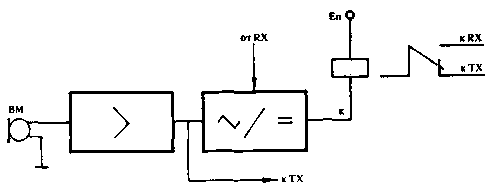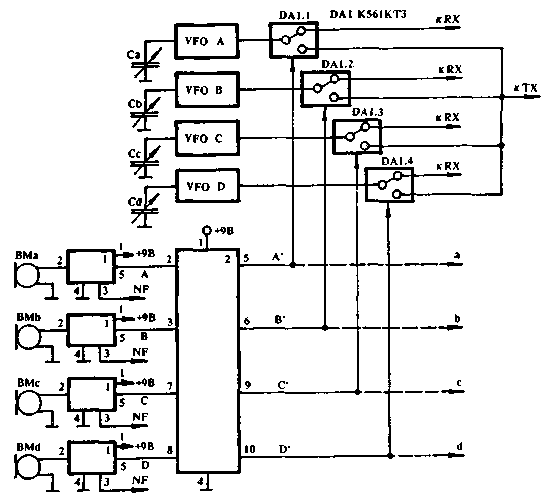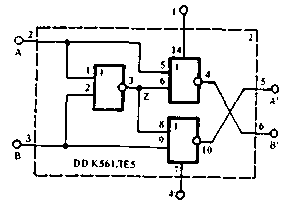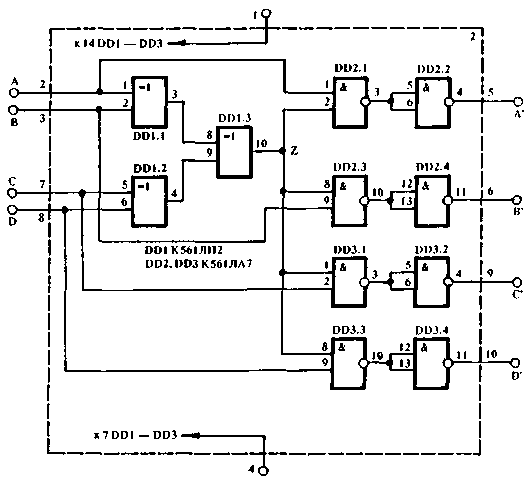MULTIVOX schematic for transceiver. Encyclopedia of radio electronics and electrical engineering

Encyclopedia of radio electronics and electrical engineering / Nodes of amateur radio equipment
 Comments on the article
Comments on the article
The traditional VOX system [1] contains a microphone amplifier, the signal from which is fed to a low-frequency amplifier (ULF), filters, a balanced modulator, etc., as well as to a speech signal converter operating on the principle: there is an audio over-threshold signal at the input - at the output - "logical unit"; no signal - "logical zero" (Fig. 1).

Fig. 1
In the presence of a sound signal, relay K is activated, switching the contacts of the radio station circuit to receive or transmit. Sometimes a signal from the ULF of the receiving part is introduced into the converter circuit to prevent the VOX system from triggering from the speaker. In such circuits, electromechanical relays are usually used, the disadvantages of which include contact bounce, response delay, a high level of switching noise, high power consumption and low reliability.
The MultiVOX system (Fig. 2 - 5) has high speed and reliability, low power consumption and can be used at collective radio stations for operator training. The use of the MulliVOX system is especially effective in competitions (many operators - one transmitter, many operators - many transmitters).

Fig.2 (click to enlarge)
The circuit (Fig. 3) consists of n identical VOX channels (Fig. 2, block 1), the signals from which are fed to the switching unit (Fig. 3, 5, block 2). Switching unit 2 passes control signals only from the channel that is currently in use.

Ris.3
If a signal accidentally appears on any other channel, the passage of control signals is prohibited by the switching unit and the radio station works only for reception. So, if four operators work at a radio station, three of them listen to the air, looking for correspondents by range (bands); and one conducts a radio exchange with the next correspondent. After the end of radio communication, another operator calls the next correspondent, and the rest work on reception. It is assumed that each operator has its own smooth range generator (VFO), its own part of the receiving path. When working on transmission, only one of the generators is switched on in the transmitting path, and simultaneous work on the air of two operators (working on two frequencies) is excluded.
Block 1 (Fig. 2, 3) is a conventional VOX, consisting of a microphone preamplifier based on a KT315 transistor (or its low-noise analogue), from the output of which (pin 3) a low-frequency (LF) signal is fed to a single-sideband signal shaper. From the preamplifier, the low-frequency signal also goes to the comparator, made on the K554SAZ chip. Instead of the load resistor R7, a relay can be switched on, for example, RES-9, in parallel with the winding of which a capacitor with a capacity of up to 100 microfarads should be connected. For individual radios, the control signal can be taken from terminal 5 of block 1 without using switching unit 2.
Potentiometer R2 sets the sensitivity of the VOX device to the speech signal, R6 - the threshold of the comparator. To increase the level of the output control signal (pin 5 of block 1) by increasing the constant component in the output signal from 0 to 3 - 4V, point A of the circuit block can be disconnected from the common wire and connected to the potentiometer R10 engine.
The MultiVOX circuit (Fig. 3) allows you to work from any control panel (microphones BMa...BMd). The diagram of the VFO signal switch (DA.1...DA1.4) is given conditionally. Switch channels can be used for switching analog signals, including sufficiently high-frequency ones, with an amplitude (from peak to peak) up to 50% of the microcircuit supply voltage (3-15 V - for K561, K564), or switching buffer stages or powerful relay circuits for direct current.
The number of simultaneously switched circuits can be increased by connecting the control electrodes of the switches in parallel (Fig. 3, additional outputs a...d). Between the control inputs of the switches X and Y, RC elements and diodes can be connected, which will make it possible to realize the operation of the corresponding switches, which is different in time.
Options for switching units 2 are shown in Fig. 4a (for two operators) and Fig. 4b (for four operators).

Fig.4a

Fig.4b
When working by telegraph, control signals from keys (electronic keys) can be applied directly to the corresponding inputs of block 2.
Literature
1. Bunimovich S.G., Yaylenko L.P. Technique of amateur single-sideband radio communication. - M.: DOSAAF, 1970.-312s.
2. Analog and digital integrated circuits: Reference manual / S.V. Yakubovsky and others - M .: Radio and communication, 1984. -432 p.
Author: Shustov M., Tomsk; Publication: N. Bolshakov, rf.atnn.ru
 See other articles Section Nodes of amateur radio equipment.
See other articles Section Nodes of amateur radio equipment.
 Read and write useful comments on this article.
Read and write useful comments on this article.
<< Back
 Latest news of science and technology, new electronics:
Latest news of science and technology, new electronics:
Artificial leather for touch emulation
15.04.2024
In a modern technology world where distance is becoming increasingly commonplace, maintaining connection and a sense of closeness is important. Recent developments in artificial skin by German scientists from Saarland University represent a new era in virtual interactions. German researchers from Saarland University have developed ultra-thin films that can transmit the sensation of touch over a distance. This cutting-edge technology provides new opportunities for virtual communication, especially for those who find themselves far from their loved ones. The ultra-thin films developed by the researchers, just 50 micrometers thick, can be integrated into textiles and worn like a second skin. These films act as sensors that recognize tactile signals from mom or dad, and as actuators that transmit these movements to the baby. Parents' touch to the fabric activates sensors that react to pressure and deform the ultra-thin film. This ... >>
Petgugu Global cat litter
15.04.2024
Taking care of pets can often be a challenge, especially when it comes to keeping your home clean. A new interesting solution from the Petgugu Global startup has been presented, which will make life easier for cat owners and help them keep their home perfectly clean and tidy. Startup Petgugu Global has unveiled a unique cat toilet that can automatically flush feces, keeping your home clean and fresh. This innovative device is equipped with various smart sensors that monitor your pet's toilet activity and activate to automatically clean after use. The device connects to the sewer system and ensures efficient waste removal without the need for intervention from the owner. Additionally, the toilet has a large flushable storage capacity, making it ideal for multi-cat households. The Petgugu cat litter bowl is designed for use with water-soluble litters and offers a range of additional ... >>
The attractiveness of caring men
14.04.2024
The stereotype that women prefer "bad boys" has long been widespread. However, recent research conducted by British scientists from Monash University offers a new perspective on this issue. They looked at how women responded to men's emotional responsibility and willingness to help others. The study's findings could change our understanding of what makes men attractive to women. A study conducted by scientists from Monash University leads to new findings about men's attractiveness to women. In the experiment, women were shown photographs of men with brief stories about their behavior in various situations, including their reaction to an encounter with a homeless person. Some of the men ignored the homeless man, while others helped him, such as buying him food. A study found that men who showed empathy and kindness were more attractive to women compared to men who showed empathy and kindness. ... >>
 Random news from the Archive Random news from the Archive 5nm IBM chip
05.06.2017
IBM IT Corporation announced the creation of the first working samples of processors with 5 nanometer transistors. The development was carried out jointly with GlobalFoundries and Samsung Electronics.
The new technology allows up to 30 billion transistors to be placed on a single chip the size of a human fingernail and used in a variety of equipment - from smartphones to spacecraft. The world's first 7nm chips, announced by IBM two years ago, had 20 billion transistors.
A higher density of transistors in a microcircuit increases the speed of the signal passing between them. IBM claims that 5nm solutions are 40% more productive than current 10nm chips, or 75% more energy efficient than them at the same speed.
The presented chip uses a new type of transistors, combined in the so-called silicon nanosheets (silicon nanosheets). They send electrons through four gates, while in the case of FinFET transistors (considered the most advanced at the moment on the mass market), we are talking about three gates. FinFET technology has appeared in 22nm and 14nm semiconductors and is expected to remain in 7nm chips. The semiconductor industry is moving away from FinFET because the technology is not geometrically scalable, said Mukesh Khare, vice president of semiconductor research at IBM Research.
"Going beyond 7nm is an important innovation," comments Hare. "It's an innovation in terms of design and how more transistors are put together. This transistor structure paves the way for a true 5nm process."
At the moment, it is still too early to talk about the commercial release of 5-nm chips (tentative dates - 2020). However, it is already known that for the production of such solutions, IBM will use the technology of photolithography in deep ultraviolet (extreme ultraviolet lithography, EUV).
|
 Other interesting news:
Other interesting news:
▪ controlled bacteria
▪ USB 3.0 up to 100m
▪ Trains instead of planes
▪ Knowing the plot does not spoil the pleasure of reading
▪ Large memory audio player
 News feed of science and technology, new electronics
News feed of science and technology, new electronics
 Interesting materials of the Free Technical Library:
Interesting materials of the Free Technical Library:
▪ site section Electric motors. Article selection
▪ article With nature alone he breathed life. Popular expression
▪ article Why do mosquito bites itch? Detailed answer
▪ article Kalgan officinalis. Legends, cultivation, methods of application
▪ article Oils and creams for hair. Simple recipes and tips
▪ article VHF antenna with vertical polarization. Encyclopedia of radio electronics and electrical engineering
 Leave your comment on this article:
Leave your comment on this article:
 All languages of this page
All languages of this page
Home page | Library | Articles | Website map | Site Reviews

www.diagram.com.ua
2000-2024







 Arabic
Arabic Bengali
Bengali Chinese
Chinese English
English French
French German
German Hebrew
Hebrew Hindi
Hindi Italian
Italian Japanese
Japanese Korean
Korean Malay
Malay Polish
Polish Portuguese
Portuguese Spanish
Spanish Turkish
Turkish Ukrainian
Ukrainian Vietnamese
Vietnamese





 Leave your comment on this article:
Leave your comment on this article: